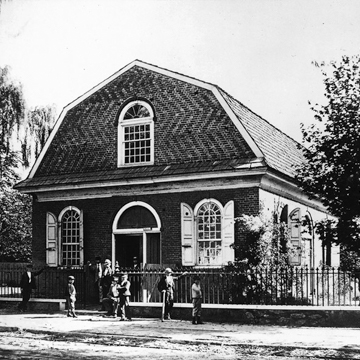The one-story, gambrel-roofed brick church was moved to Brandywine Park from downtown early in the twentieth century as a historic shrine, having been built just nine years after the founding of Willingtown. Originally, it stood at the intersection of Market Street and the thorough-fare called the “great road leading to the rocks” where the Swedes had landed. (In today's terms, the church occupied the site of the rear corner of Wilmington Public Library [WL28], for the construction of which it had to be relocated.) Facing two major roads, it had two entrances. Its construction date is marked on the north wall in glazed bricks. Zigzag patterning in the brick-work recalls southern New Jersey practice. It became a school in the 1840s after a larger church was erected nearby. Bancroft Mills executive Henry B. Thompson (see WL91) had Frank Miles Day prepare plans for its restoration in 1910 for the Historical Society of Delaware; these were never executed.
When the venerable building was threatened with demolition not long after, the Society of the Colonial Dames and the Society of Colonial Wars helped pay for its move to Brandywine Park in October 1917. The old mortar was so hard, many bricks could not be salvaged, so only three-quarters of the walls are made of original material. The leaded fanlights of the windows, long hidden, were a surprising discovery during the building's disassembly. The entrance doors are May's design based on historical precedent, as is much of the interior. Its successor congregation is First and Central Presbyterian Church (WL35), in which a Stanley Arthurs painting (1930) shows the colonial building in its heyday. Between the church and the riverbank runs Brandywine race (1900), which still supplies the city with water. North of the church is a sculpture, the President McKinley Memorial (1908, moved here 1971).





